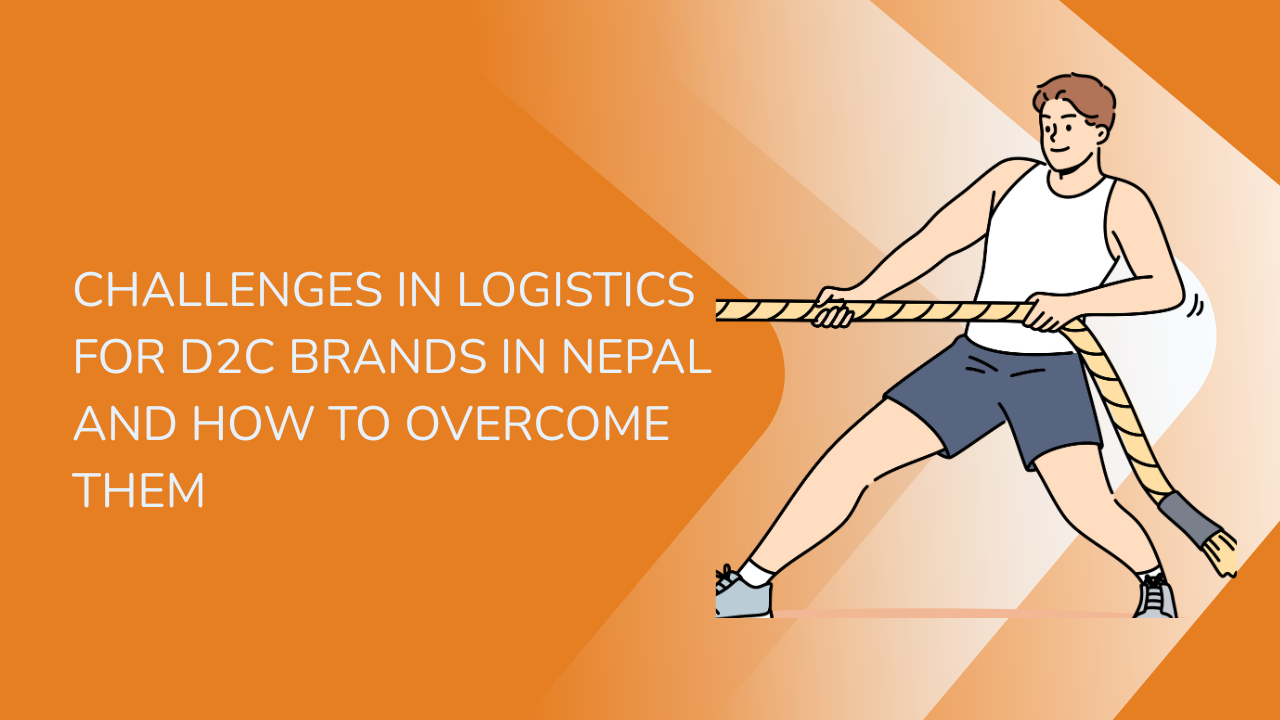Share this Article
The rise of Direct-to-Consumer (D2C) brands in Nepal has significantly altered the e-commerce landscape, offering consumers an easy and convenient way to purchase products directly from brands. However, one of the biggest hurdles that these brands face in Nepal is the challenge of logistics. Effective logistics and supply chain management are essential for D2C brands to deliver products on time and meet customer expectations. As Nepal is a country with a unique geographical layout, limited infrastructure, and varying consumer demands, managing logistics can be particularly difficult for businesses that operate directly with consumers.
In this blog, we will discuss the major logistical challenges faced by D2C brands in Nepal and explore the innovative solutions being implemented to overcome them. From issues with last-mile delivery to infrastructure limitations, the following sections will provide a comprehensive overview of the logistical difficulties and how companies are tackling these obstacles to succeed in the Nepali market.
1. Geographical Challenges in Nepal
Nepal's diverse topography, which ranges from the Himalayan mountains to the Terai plains, presents a unique set of challenges for D2C brands when it comes to logistics. The country has remote rural areas that are difficult to access, especially in the mountainous regions. Many of these areas do not have proper road networks, which makes it hard for delivery vehicles to reach their destinations. Additionally, inclement weather conditions, such as heavy rains during the monsoon season or snowfall in the winter months, can further delay deliveries.
Challenges:
- Remote and Inaccessible Areas:
For D2C brands, ensuring timely delivery to rural and remote locations is a constant challenge. The lack of infrastructure such as well-maintained roads, or the absence of proper transportation routes in the mountains, makes it difficult to reach these areas. Delivery delays are common, and customers in these regions often face issues with receiving their orders on time.
- Weather-Related Disruptions:
Nepal experiences heavy rains during the monsoon season, and this can severely affect transportation networks. Flooding and landslides are frequent during this period, leading to delivery delays and damaged goods. Similarly, the winter season brings snowstorms and harsh weather, which can halt transportation, especially in the higher-altitude regions.
Solutions:
- Partnerships with Local Couriers and Delivery Services:
Many D2C brands are tackling the geographic challenge by partnering with local delivery services that have more knowledge of the terrain and better access to remote areas. Local couriers are often more familiar with the challenges posed by difficult road conditions, and they can use alternative routes that larger courier companies may not be able to access. These partnerships help ensure timely deliveries, even in hard-to-reach areas.
- Utilizing Smaller Delivery Vehicles:
In areas with poor road conditions, large delivery trucks may not be able to navigate effectively. D2C brands are overcoming this challenge by using smaller vehicles, such as motorcycles or three-wheelers, that can reach areas where larger vehicles might be unable to travel. Motorbikes are often used to deliver products quickly in congested urban areas and remote regions alike, improving delivery efficiency and reducing delays.
- Investing in Weather-Resilient Logistics:
D2C brands can invest in weather-resilient logistics solutions by partnering with delivery services that have experience navigating Nepal's challenging weather conditions. This could include diversifying transportation methods, using vehicles suited for rugged terrains, and having contingency plans in place to manage delays due to adverse weather.
2. Lack of Infrastructure and Road Networks
Nepal's infrastructure, particularly in rural areas, is still underdeveloped. While the capital city of Kathmandu and some larger cities have modern roads, many remote areas lack proper infrastructure, and roads are often unpaved or poorly maintained. Additionally, many parts of the country do not have reliable transportation networks, which complicates the process of moving goods efficiently.
Challenges:
- Poor Road Quality:
Inadequate road conditions are one of the biggest logistical challenges in Nepal. In many regions, roads are not properly paved or maintained, leading to delays in deliveries and damage to goods. The lack of infrastructure impacts the efficiency of delivery services and increases operational costs.
- Limited Transportation Options:
While larger cities may have a variety of transportation options, rural areas may lack regular transportation services. As a result, D2C brands find it difficult to find reliable means of transport, which increases delivery time and costs. Limited public transportation and the absence of professional logistics providers in remote regions further exacerbate the situation.
Solutions:
- Investing in Infrastructure Development:
D2C brands are beginning to invest in improving their internal logistics systems. Some companies are building their own warehouses or distribution centers in strategic locations, especially in areas where infrastructure is lacking. These warehouses can serve as hubs from which products can be distributed more efficiently.
- Leveraging Technology for Efficient Routing:
Technology plays a vital role in overcoming infrastructure challenges. D2C brands are increasingly relying on route optimization software to plan the best delivery routes and minimize delays. These technologies use real-time traffic data to adjust delivery paths, helping drivers avoid congested areas and roads that may be in poor condition. In turn, this reduces delivery time and improves overall customer satisfaction.
- Collaborating with Government and NGOs:
D2C businesses can also collaborate with the government or NGOs to help improve infrastructure in rural areas. In some cases, businesses are working alongside governmental projects to develop better roads, bridges, and transportation systems in underserved regions. While this is a longer-term solution, it can greatly benefit businesses and consumers in the future.
3. Last-Mile Delivery Issues
The "last mile" of delivery refers to the final leg of the journey when the product is delivered directly to the consumer's doorstep. This stage of delivery is often the most costly and logistically challenging for e-commerce businesses, especially in countries like Nepal where transportation infrastructure is underdeveloped. Last-mile delivery is critical for D2C brands because it directly impacts customer satisfaction.
Challenges:
- High Cost of Last-Mile Delivery:
Last-mile delivery is often the most expensive part of the logistics process, especially in Nepal, where large portions of the population live in rural areas with limited access. Due to the geography and lack of infrastructure, D2C brands must invest heavily in last-mile logistics, which can reduce profit margins.
- Unpredictable Delivery Times:
With the lack of reliable transportation networks and the challenges posed by Nepal's mountainous terrain, last-mile delivery times are often unpredictable. This leads to delays and unhappy customers, which can harm a D2C brand's reputation.
- Limited Tracking Systems:
Many delivery services in Nepal still lack advanced tracking systems that allow customers to track their orders in real-time. This creates uncertainty for customers who may be unsure about when their packages will arrive, leading to frustration and a poor customer experience.
Solutions:
- Partnering with Delivery Aggregators:
One way D2C brands are overcoming last-mile delivery issues is by partnering with delivery aggregators that specialize in managing and optimizing last-mile logistics. These aggregators often work with local delivery partners to create a more extensive network of couriers who can handle deliveries in both urban and rural areas.
- Flexible Delivery Options:
Offering flexible delivery options is another way D2C brands can address last-mile delivery challenges. For example, providing customers with the option to choose delivery windows or pick-up points where they can collect their orders is an effective solution. This reduces the logistical burden on businesses and allows customers to choose a delivery time that is convenient for them.
- Improving Customer Communication and Transparency:
D2C brands can improve last-mile delivery experiences by offering better communication channels. Real-time tracking systems, SMS or email updates, and customer support teams that can provide timely updates on delivery status help customers feel more informed and reassured. This improves overall customer satisfaction, even when there are delays.
4. Limited Local Delivery Networks and Workforce
A significant issue for D2C brands in Nepal is the lack of a reliable local delivery network. While major cities have well-established courier services, smaller towns and villages often rely on limited options, which can lead to inefficiencies and delays. Additionally, there may be a shortage of trained workers in the logistics sector, which makes it difficult for D2C businesses to scale their operations effectively.
Challenges:
- Scarcity of Skilled Workforce:
The logistics industry in Nepal faces a shortage of skilled workers, including delivery drivers and logistics managers. This results in inconsistent service quality, delayed deliveries, and a lack of professionalism in the delivery process.
- Limited Local Delivery Providers:
Smaller towns and remote regions often lack sufficient delivery providers, which makes it difficult for D2C brands to provide fast and reliable shipping in these areas.
Solutions:
- Developing Training Programs for Delivery Personnel:
D2C businesses can collaborate with local delivery services to provide training programs that focus on improving the professionalism and efficiency of delivery personnel. Training workers on best practices in logistics, customer service, and safe driving can help improve the overall quality of the service.
- Building In-House Logistics Teams:
To mitigate the reliance on external logistics providers, some D2C brands are developing in-house delivery teams that can offer better control over the quality of service. These teams are trained specifically for handling D2C deliveries, improving reliability and consistency in delivery times.
Conclusion
Logistics challenges in Nepal are significant but not insurmountable. D2C brands are continuously exploring innovative solutions to overcome obstacles like poor infrastructure, last-mile delivery inefficiencies, and geographical barriers. By leveraging technology, partnering with local couriers, investing in weather-resilient logistics, and improving the last-mile delivery process, D2C businesses can improve their logistics operations and enhance customer satisfaction.
As Nepal’s e-commerce market continues to grow, overcoming these logistical challenges will be critical to ensuring that D2C brands can compete and succeed in the long term. By addressing these issues head-on, D2C brands can build more resilient and efficient logistics networks, leading to greater consumer trust and loyalty, and ultimately, higher sales and profitability.
Categories:
Marketing & Growth
Tags:
strong brand







